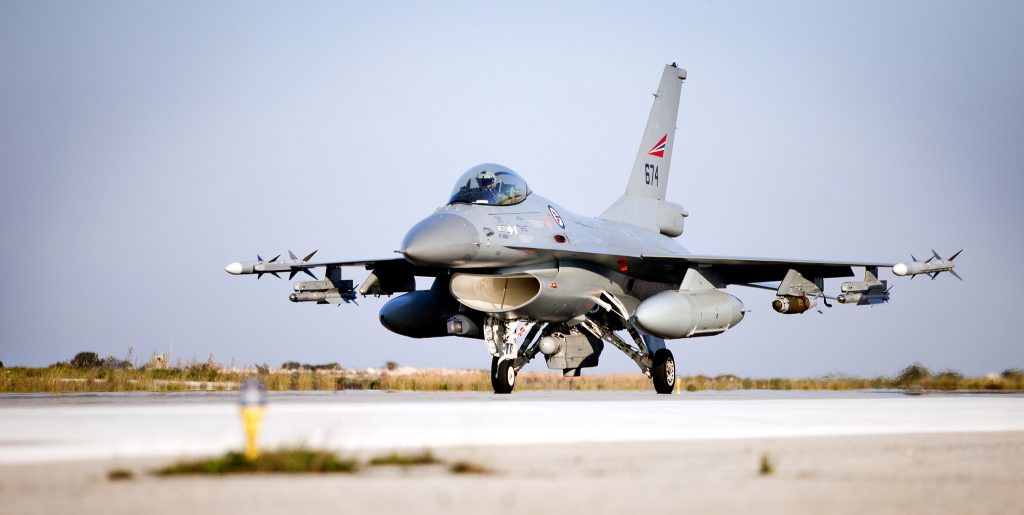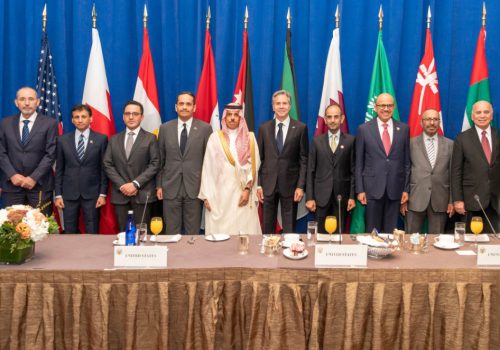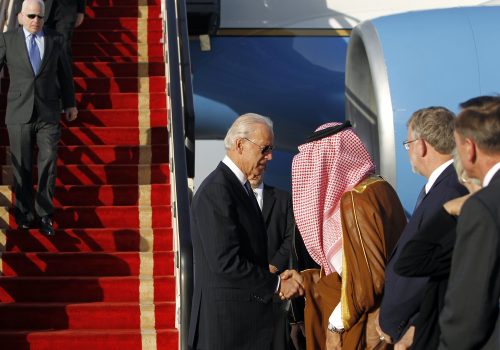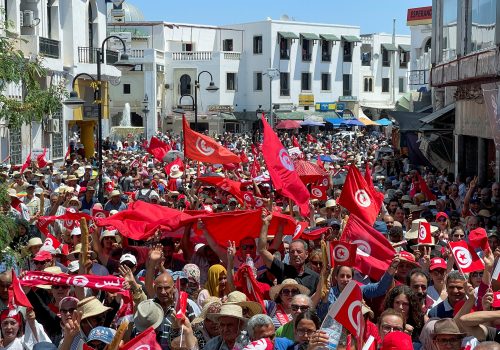Libya’s decade of crisis
In March 2011, a coalition of countries under the United Nations (UN) umbrella and led militarily by the North Atlantic Treaty Organization (NATO) launched an air campaign in support of a series of revolts against the regime of Mu’ammar Qadhafi in Libya, ostensibly to stop Qadhafi’s reprisals on civilians. By the end of October, Qadhafi was dead and his regime had collapsed. A number of NATO countries, as well as the European Union (EU) committed themselves to supporting Libya’s stabilization and democratization. But in fact, the intervention’s aftermath saw the disintegration of the country. The following decade was punctuated by military escalations, culminating in two further wars in 2014-15 and 2019-20, which were at the same time intra-Libyan wars and proxy wars waged by regional and global powers such as Russia, Turkey, Egypt, the United Arab Emirates (UAE), Qatar, France, and Saudi Arabia, each supporting a local party in the conflict with weapons, mercenaries and occasionally some regular forces.
Furthermore, the collapse of central authority in Libya favored the expansion of jihadi groups, including the Islamic State (ISIS), and the establishment of lucrative illicit activities, including arms, drugs and people smuggling. Currently, Libya is still a divided country, with two competing governments based in Tripoli and Sirte. Over 800.000 people out of some 7 million living in the country are in desperate need for humanitarian assistance, and an unknown number of migrants, possibly up to 600,000, are stuck in inhuman detention centers along Libya’s coast, where they suffer well documented abuses. Unable to prevent large-scale human suffering on the ground, the Western promoters of the 2011 intervention, as well as the EU – which supported it politically and attempted to play a key role in Libya’s reconstruction – have also failed to protect vital Western interests in the region. As a consequence of the Libyan crisis, Europe was exposed to a number of challenges and threats, including the spread of jihadism a mere 180 miles from EU territory, an unprecedented migration crisis via the Central Mediterranean, and the decrease in hydrocarbon imports from Libya due to sporadic drops in Libyan production. Additionally, NATO and EU countries have progressively lost influence in the region to the benefit of external players largely hostile to them.
NATO, the Afghanistan syndrome and the limits of half measures
The irony about the 2011 intervention is that, although it became associated with NATO and was even considered a manifestation of NATO’s imperialism1M.D. Nazemroaya, La globalizzazione della NATO: Guerre imperialiste e globalizzazioni armate (Bologna: Arianna Editrice, 2012), 226., the anti-Qadhafi campaign was not planned and executed as a proper NATO operation. By the time NATO intervened with Operation Unified Protector (OUP) on 31 March, four operations were already ongoing against Qadhafi (one French, one British, one American and one Canadian). The Alliance, heavily committed in Afghanistan, was unhappy to be involved in Libya, and was divided. Some member states, such as Britain and Italy, were willing to use NATO assets; many more, including France (the most active promoter of the anti-Qadhafi intervention), Germany, Turkey and the Eastern European members were either unconvinced or totally uninterested, each for its own reason. The US, for its part, supported the intervention but wanted to take a backseat – what President Barak Obama famously termed “leading from behind.” The final decision to involve NATO in the conflict was dictated by military considerations, namely the need for better coordination, clearer command and control and stronger assets as the war lasted for longer than anticipated.2C.S. Chivvis, Toppling Qaddafi: Libya and the Limits of Liberal Intervention (New York: CUP, 2014), 71.
Accordingly, NATO Secretary General Anders Fogh Rasmussen promised that the Alliance would protect the Libyan people and ensure a “smooth and inclusive transition” to a united state “founded on reconciliation and respect of human rights.” Despite that rhetoric, however, the Alliance continued to show limited interest in a serious and prolonged commitment and was self-restrained in a number of aspects, which hampered its overall ability to properly manage the crisis.
At the political level, and in contrast to previous NATO operations, the direction of the war was not given to the North Atlantic Council (NAC), the political body of the Alliance, but to a Libya Contact Group made of delegates of the countries participating in the coalition. NATO was only tasked with the military operations. That meant that NATO could not exercise political oversight of non-NATO members of the coalition, some of which – especially the Qataris and the Emiratis – played a critical role in arming and training some Libyan rebel factions bilaterally. But this strengthened peripheral forces in Libya at the expense of the authority of the newly-constituted National Transitional Council (NTC) – the political forum that gathered representatives of the various anti-Qadhafi groups. This situation exacerbated intra-Libyan rivalries and tied specific rebel militias to foreign patrons that would later use that leverage to wage a proxy war in Libya.
At the strategic level, the Libya Contact Group opted for the stricter possible interpretation of UN Security Counsil Resolution (UNSCR) 1973 authorizing “all necessary means,” short of “occupation forces,” to protect Libyan civilians and adopted the “no boots on the ground” rule for NATO. This served to meet anxieties in NATO countries that they would not be dragged into a prolonged nation-building endeavor, and to foster greater international support for the operation. But without ground support, NATO’s air assets experienced growing difficulty in distinguishing between rebel forces and Qadhafi loyalists, which slowed down operations and led to increasing (perhaps avoidable) collateral damage. This also spurred individual member states, in particular France and Britain, to pursue a number of initiatives parallel to OUP, including the deployment of Special Forces which was seen internationally as a violation of the “no boots on the ground” rule and which alienated important players, including the African Union and Russia.3Nazemroaya, La globalizzazione della NATO, 25.
NATO was also handicapped operationally by the limited assets available. At its peak, OUP involved about 260 aircraft – approximately one quarter of the force dedicated to the 1998 Kosovo operation at its height. This was a consequence of the ‘coalition formula’ for the intervention itself, which allowed half the Allies – including all the Eastern European members – to decline their participation.4Chivvis, Toppling Qaddafi, 100. Such decision, which broke the traditional NATO motto “all for one, one for all,” was another consequence of the lack of a political commitment of the Alliance as a whole.
When OUP ended, NATO military authorities made a strong case that, without a stabilization force to ensure a peaceful post-conflict transition, and without prolonged support to the fragile Libyan leadership that had emerged from the revolution, the risk of chaos and state failure was serious. Secretary General Rasmussen agreed.5R. Weighill and F. Gaub, The Cauldron: NATO’s Campaign in Libya (London: Hurst&Co, 2018), 209. Some plans were drafted, in coordination with the UN and the EU, which included a three-layer scheme for the disarmament, demobilization and reintegration (DDR) of Libyan militiamen.6Interview with a NATO diplomat, September 24, 2019. However, virtually all NATO member states were anxious to avoid “anything remotely resembling an Afghanistan scenario.”7Interview with a former NATO analyst, June 5, 2020. The new Libyan authorities themselves were uninterested in a foreign presence in their country, possibly without fully realizing the challenges that lay ahead. Thus, what NATO offered to Libya in the intervention’s aftermath was technical support in defense capacity building, an option that remained in the air to date, while individual member states attempted limited DDR schemes for Libyan militiamen outside Libya. These were characterized by common problems: lack of coordination, differing training and selection standards, and lack of a monitoring mechanism for the reintegration of the trained personnel into Libya. The Libyan trainees were “flown back, and then they disappeared into the background.”8Interview with a former British ambassador to Libya, October 1, 2019. By 2015, all programs were shut down in frustration.9Weighill and Gaub, The Cauldron, 157-158.
This left Libyan authorities alone in dealing with the multitude of armed groups, which spurred the fateful decision of the NTC to appease them with a salary. This not only legitimized the militias, but attracted more and more militiamen (from some 40,000 in 2012 to 250,000 two years later), and with less appetite for disarmament. 10R. Alaaldin, F. Saini Fasanotti, A. Varvelli, and T.M. Yousef, eds., The Rise and Future of Militias in the MENA Region (ISPI, 2019), 44. They came to dominate Libya’s political landscape, kidnapping politicians, imposing legislation at gunpoint, and extracting funds from Libya’s economic institutions. Libya was set on a path of warlordism, sectarianism and incumbent political violence.
The EU and the limits of soft power
The organization that stepped forward to help stabilize Libya after the war was the EU, under the direction of a UN support mission to Libya (UNSMIL). The EU promised to provide an “essential and a clear contribution to promoting peace in our immediate neighborhood.” Initially, the EU resorted to its classic soft power toolkit of assistance, financial, training and development programs. To date, the Union has invested €44.5 million in humanitarian assistance in Libya; it is contributing to 23 projects worth €70 million in bilateral support and has financed the Covid-19 response in Libya with €66 million. Additionally, €408 million have been mobilized under the EU Emergency Trust Fund for Africa to help Libya cope with the migration challenge.
These programs suffered from two main problems. One was technical. Under Qadhafi, Libyans drew a state salary that did not imply actual work but rather loyalty to the regime. Since salaries were not connected to any constructive output, “there was no incentive to create an even moderately functional government bureaucracy.” For EU funding mechanisms, Libya was “like a plug without a socket.”11Interview with a European Union official, February 11, 2021. This was aggravated by the inconsistencies and duplication of efforts in EU financial schemes. The result was that “Libyans simply didn’t know where to look to get the money for any given activity.”12Interview with a European Union official, January 29, 2021. A second problem was the lack of security, which hampered the implementation of any development program.13S. Marcuzzi, The EU, NATO and the Libya Conflict: Anatomy of a Failure (London: Routledge, 2021), 108-111.
The EU delegation to Libya assessed the need for stronger measures in the security field as early as late 2011.14Ibid., 101. Over the years, a number of options were debated in EU circles, including a 5,000-strong EU force to be deployed in and around Tripoli to oversee “arrangements for the withdrawal of armed groups … and the cantonment of heavy weapons” preparatory to “a number of civilian CSDP policing and Rule of Law (RoL)/SSR related Missions.” These schemes were never implemented due to a combination of issues: a deeply-ingrained normative culture in the Union, which was seen as incompatible with the use of hard power; the inconsistencies among those EU member states more involved in Libya – especially Italy and France, which ended up siding with different Libyan factions; and the lack of an invitation by the transitional Libyan authorities. Instead, an EU Border Assistance Mission (EUBAM) was established, which proved just too weak to make a difference. The EU hoped that an elected Libyan Government would feel more legitimized to invite a stabilization force, but the opposite happened. Without stability and security, the 2012 Libyan elections saw a crescendo of political violence and human rights violations. The EU, which was monitoring the elections, took no action. In the years that followed, militia infighting derailed Libya’s democratization process to the point that the subsequent 2014 elections ignited another civil war in the country, with two governments, one based in Tripoli and the other in Bayda and each supported by a different assembly and by a different coalition of militias, competing for power.
From 2015 onwards the EU began to scale down its own ambitions and tried to address some specific aspects of the Libyan crisis, namely the migration problem and the smuggling of weapons into the country. It did so through two naval operations, EUNAVFOR MED Sophia and Irini (the latter launched in March 2020). Both operations remained chronically under-resourced – at its peak, Sophia had seven ships and seven air assets, while Irini had four and six – and suffered from self-imposed limitations that impeded a strategic impact. The most serious limitation for Sophia was the EU decision to refrain from pressing the new Libyan Government of National Accord (GNA) established at Skhirat, to allow the operation into Libya’s territorial waters. That was crucial to dismantle the human smugglers networks, which was Sophia’s priority. Without Tripoli’s consent, the operation could never move beyond phase one (out of four planned phases). The EU tried to compensate by training the Libyan Coastguard, but that was seen by Libyans as an attempt at “dump[ing] the dirty job to us,” 15Interview with a Libyan analyst, September 25, 2019. and also favored a number of human rights violations against the migrants.
Irini’s main handicap lay in the mandate of the operation itself, which flew from UNSCR 2292. The latter was based on the concept of ‘compliant boarding’, which Russia and China insisted be included in the resolution. As a consequence, Irini ships can only inspect vessels suspected of transporting war-related material to Libya if granted permission from the ships’ flag nations. Naturally, this limits Irini’s enforcement and deterrent potential. In some cases, Turkish cargos approached the Libyan coast with a military escort that threatened to open fire on the European ships if they attempted to stop the convoy. The Europeans withdrew.16Marcuzzi, The EU, NATO and the Libya Conflict, 176-178.
The EU inability to use hard power to supplement its soft power tools led to a progressive loss of leverage in the region, evidenced by the establishment of a strongly pro-Turkish government in Tripoli under Abdulhamid Dabaiba in March 2021, while a parallel, Russia-recognized government was established in Sirte under Fathi Bashagha a year later.17Marcuzzi, “The Role of the EU in the Libyan conflict since 2011,” KAS, Libya Brief n. 11, May 2022, 14-15.
Relaunching crisis management, or scaling ambition down?
The Libyan crisis is revealing of a trend of “bold commitment but compromised means” common to both NATO and the EU. NATO’s half-hearted 2011 intervention left a power vacuum from which a number of threats to NATO member states emerged; that vacuum has eventually provided Russia – NATO’s main rival – with a foothold on a strategic region, rich in hydrocarbon resources. For the EU, the Libyan crisis is the story of a short-circuit between the Union’s foreign policy paradigm based on soft power, and the needs of a hard security crisis. Both organizations failed to fulfil their promises to the Libyan people, and lost leverage in the region as a result. This calls into question the rationale and future of Western/liberal crisis management.
A first takeaway from Libya is that half measures hardly work. Although it is impossible to ultimately prove or disprove a counterfactual, there is much evidence that the collapse of Libya was not inevitable.18W. Lacher, Libya’s Fragmentation: Structure and Process in Violent Conflict (London: Tauris, 2020), 19. A peacekeeping force in the aftermath of the 2011 operation; prompt reaction against the first disruptors of Libya’s peaceful transition in 2012; stronger enforcement mechanisms attached to subsequent UN-orchestrated political agreements between rival Libyan factions in 2015 and 2020; and punitive measures against Libyan and international spoilers of those agreements may have prevented or at least contained the spiral of violence that engulfed the country.
A second lesson is that a stronger EU and NATO political role is needed. Both organizations tended to operate through technical tools in Libya, leaving the political leadership to other international forums – the Libya Contact Group and the UN. Though understandable, this has proved increasingly problematic. The UNSC became paralyzed by actors, chiefly Russia, but increasingly China too, who grasped the possibility to impede or hamper Western action in Libya by formulating UN resolutions that disempowered the mandates of Western-led operations. Subsequent failure of Western initiatives contributed to deliver a message to local and international players that unilateralism in open violation of UN resolutions, could be pursued with impunity in Libya.
If NATO, the EU and their member states are not prepared to address these problems and ‘change step’ in their future crisis management, they may have to scale down their expectations but also revise their rhetoric. Hyperbolic statements and promises of cathartic interventions by either organization are recipes for reputational damage when they are not matched by positive results. In an increasingly militarized world, a lower profile may be insufficient to secure Western interests and promote peace and stability; but it would at least prevent accusations of hypocrisy and hybris.
Stefano Marcuzzi is a Marie-Curie Fellow at University College Dublin
and a Visiting Scholar at Carnegie Europe.
In partnership with

Further reading
Fri, Oct 7, 2022
The MENA region’s uneasy path towards reforms
Report By
Decade-old geopolitical transformations have impacted the Middle East and North Africa (MENA) states’ efforts to implement socioeconomic reforms. More recently, the Ukraine war’s reverberations are also likely to affect the MENA countries’ paths towards such reforms.
Tue, Jul 12, 2022
Evolving MENA power balances: What is next for US engagement in the region?
In-Depth Research & Reports By
US President Joseph R. Biden Jr.’s upcoming visit to the Middle East provides an opportunity to assess what role the United States will play in the Middle East and North Africa in the future. With the war in Ukraine further diverting US attention from the region, the big question is whether the region is entering a ‘post-US’ era.
Mon, Aug 29, 2022
North Africa’s transatlantic relations amid change and continuity
Report By
The purpose of this report is to identify a potential role for Italy and its diplomacy to play in North Africa, in full agreement and collaboration with the United States and the other main European actors.
Image: Norwegain F-16 back at Souda Air Base at Crete after fligths over Libya where they delivered total of three bombs during the mission under Operation Odyssey Dawn. Photo: NATO



